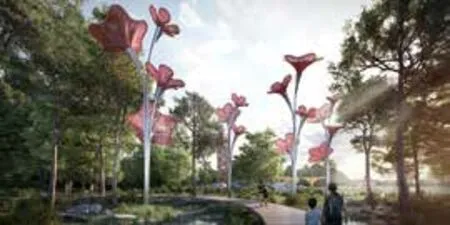湿地修复
2021-11-12AnnaGrajper,SebastianDobiesz
设计:LAX 建筑实验室 | LAX laboratory for architectural experiments (arch.Anna Grajper,arch.Sebastian Dobiesz)
排水和与水源圣河的隔离让斯塔洛瓦沃拉市的蓄水能力有所下降,修复湿地是项目的当务之急。
根据2020 年欧盟气候 LIFE 计划的指导方针,市政当局计划设计筹集资金。集中为提高城市应对气候变化的复原力找寻亲生态技术、功能和空间解决方案。并将运用基于现场凝结水蒸气技术的创新湿地复垦方法完成目标。该项目还建立了基于杜伦大学专利亲水材料技术的交互式被动大气水收集系统(IPAWC 系统)。斯塔洛沃拉市与杜伦大学合作操作系统,实施计划。
系统自身设计能够适应盛行的气候条件,水收集效率得到有效提高,且能够实时变化。系统根据该地区各区域物体的状态调节空气湿度水平、环境温度、日光强度或风力。系统交互式建筑设计的解决方案能够引起人们对水收集和积累过程的兴趣。
同时能观察IPAWC 系统的运作模式,保证重要的教育价值。对现象的经验观察帮助游客了解环境中水的流失速度以及广泛储存水的重要性。同时让游客意识到,无论是世界的哪个角落,广泛的储水对避免因蒸散造成荒漠化都至关重要。系统对不同海拔高度和自然环境如树梢、过滤岛、花草甸和沙地以及其他环境进行不同汲水处理,人们能够更加了解漏水率与基质和暴露程度的相关性,从而促进对自然界封闭水循环现象的认识。
项目的设想目标是促进开发新的、有效的湿地保水方法。即使湿地位置特殊,本课题找到了极佳的设计研究地点。城市化发展使这片土地完全融入了城市,与该地区更广泛的生物圈中的过程隔绝了。使我们能够更精确地确定使用的设计解决方案对项目执行期间实际减少排放量的影响。
The main goal of the project is the renaturalisation of wetlands in the City of StalowaWola,which has seen a deterioration in its water-holding capacity due to draining and isolation from its feeding source -the San river.
The main design assumptions were based on the guidelines of the EU“Life for Climate”program in the 2020 edition,under which the city authority plans to obtain funds.Thus,the method of shaping the projectwas subordinated to pro-ecological technological,functional and spatial solutions aimed at increasing the city's resilience to climate change.In response to these objectives,the project proposed an innovative method of wetland reclamation,based on the technology of condensation of water vapor from the site.To achieve this goal,the project proposed Interactive Passive Atmospheric Water Collection Systems (IPAWC Systems) based on hydrophilic materials technologies patented by Durham University.The implementation of the Systems was proposed on the basis of partnership betweenthe University providing the technology and the City of StalowaWola.
The Systems themselves are designed in a way that allows them to adapt to the prevailing climatic conditions,which increases the effectiveness of water collection.Their changeability takes place in real-time.Depending on the form of the objects adapted to the specific location in the area,the Systems react to the level of air humidity,ambient temperature,the level of sunlight or the wind force.The use of solutions from the field of Interactive Architecture in the design of the Systems also allows for gathering the people’s interest in the phenomenon of obtaining water and the process of its accumulation.
An important feature of the project is to guarantee the educational value of the project by making it possible to observe the modes of operation of the IPAWC Systems.Empirical observation of the phenomenon contributes to the visitors' understanding of how quickly water "escapes" from our environment and how important it is to store it widely.It draws visitors' attention to the fact that every part of the space requires a constant water supply to avoid desertification caused by evapotranspiration.Exposing the systems at different altitude levels and in various natural circumstances (in treetops,on filtering islands,among flower meadows and sandy areas,and others) allows peopleto pay attention to the rate of water leakage depending on the substrate and exposure.Thus,the project promotes knowledge about the phenomena of closed water cycles occurring in nature.
The assumed objectives of the project are to contribute to the development of new,effective methods of water retention in wetlands.The design study site is an excellent field for research in this topic due to the specific location of these wetlands.As a result of many years of urbanization,they were completely incorporated into the city and cut off from the processes occurring in the wider biotope of the region.This situation allows for greater precision in determining the impact of the applied design solutions on the real reduction of emissions during the project implementation.






